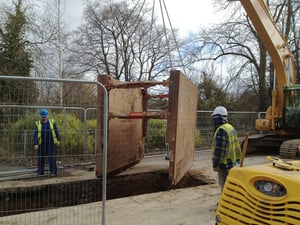 A California construction crew was excavating and installing sewer and water lines at a construction site when its trench began to collapse. Though the 17-foot deep trench had been benched, a large section of wall sloughed off. Unable to escape, a supervisor was engulfed in the soil and killed. Investigators later found that the trench’s sidewalls had been sloped for Type B soil, but it should have been classified as Type C. The case is still under review.
A California construction crew was excavating and installing sewer and water lines at a construction site when its trench began to collapse. Though the 17-foot deep trench had been benched, a large section of wall sloughed off. Unable to escape, a supervisor was engulfed in the soil and killed. Investigators later found that the trench’s sidewalls had been sloped for Type B soil, but it should have been classified as Type C. The case is still under review.
This 2018 tragedy, and others like it, are all too common. In fact, rates of injury and death associated with trenching have spiked dramatically in the United States. The cause of this uptick is still unclear. Trenching and excavating is perilous work, and any number of issues can lead to disaster.
The Bureau of Labor sounded the alarm in late 2016, when it found that the number of excavation- and trench-related fatalities were nearly double the average seen in the previous five years. That year the agency released this graph as well as a warning from Dr. David Michaels, assistant secretary of labor for the Occupational Safety and Health Administration. “Trench deaths have more than doubled nationwide since last year—an alarming and unacceptable trend that must be halted. There is no excuse. These fatalities are completely preventable by complying with OSHA standards that every construction contractor should know."
In the months that followed, OSHA made reducing trenching and excavation hazards a Priority Goal, and the efforts continue. In 2018 OSHA announced that reducing trenching and excavation accidents was again a key priority and laid out key goals and strategies to address the issue. By September 30, 2019, it aims to increase trenching and excavation hazards abated by 10 percent compared to those tallied during 2017. The agency’s specific action plan targets workplaces where there are potential trenching and excavation hazards for inspections as well as outreach. It is working closely with industry associations and public utilities to create a public-private effort to impact these injuries and fatalities. And in 2019 it will host another Trench Safety Stand Down to provide an opportunity for employers to draw attention to the specific hazards related to working in and around trenches and excavations. Disaster can only be prevented when everyone—workers, employers and regulators—work together to ensure a safe environment.
Don’t become a statistic or a news story: Make sure you, your team, and your department are informed and vigilant about the dangers of trench work. Envirosight’s latest safety poster breaks down the basics of OSHA’s mandatory guidelines so you can keep an easy reference in the truck at all times. Request yours for free today:
Lead image: Moving shoring before extending a sewer trench, York Road, Leamington
cc-by-sa/2.0 - © Robin Stott - geograph.org.uk/p/3843285


